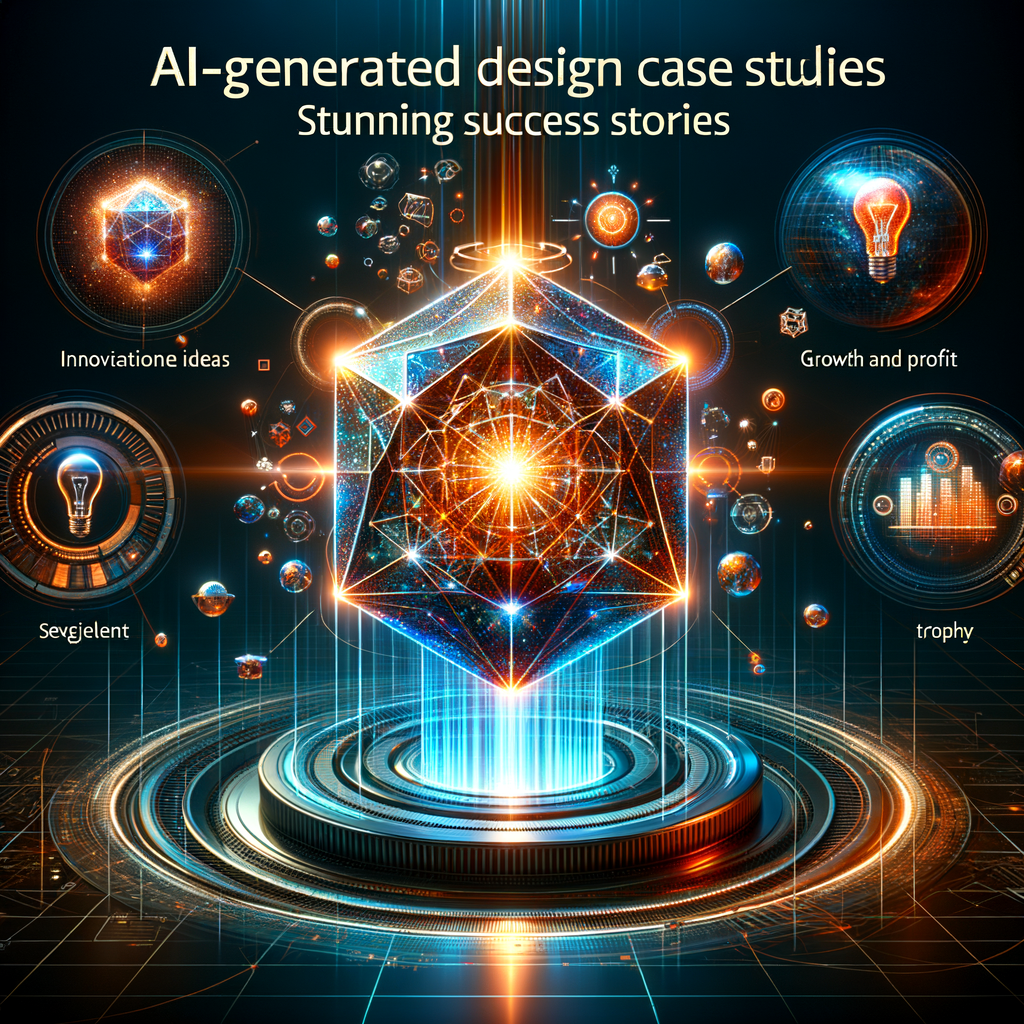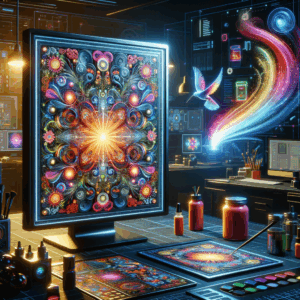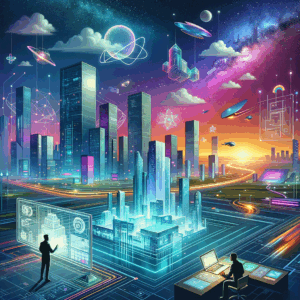
AI-Generated Design Case Studies: Stunning Success Stories
- The Rise of AI in Design
- Case Study 1: Fashion Forward with AI
- How It Works
- Impact on the Industry
- Case Study 2: Graphic Design Gets a Boost
- The Canva Experience
- Broader Implications
- Case Study 3: Elevating Architecture through AI
- Innovative Architectural Solutions
- Sustainable Designs
- Case Study 4: Advertising Takes a New Shape
- Persado's Approach
- Campaign Evolution
- The Future of AI in Design
- Embracing Collaboration
- Industry-Wide Transformation
- Frequently Asked Questions
- 1. What are AI-generated designs?
- 2. How does AI change the design process?
- 3. Can I use AI tools as a beginner designer?
- 4. Are AI-generated designs unique?
- 5. What industries are benefiting from AI in design?
- 6. Are there any drawbacks to using AI in design?
- 7. Will AI replace human designers?
- 8. How can businesses implement AI in design?
- 9. What is the future of AI in design?
- 10. Where can I learn more about AI-generated designs?
- References
The Rise of AI in Design
Artificial Intelligence has revolutionized many industries, and design is no exception. Designers now utilize AI to streamline their workflow, generate innovative ideas, and produce stunning visuals. As technology advances, designers find themselves collaborating more closely with AI tools. So, what are the outcomes of these collaborations?
Many success stories showcase how AI has transformed the design landscape. From fashion to graphic arts, AI makes it possible to create unique, eye-catching designs in record time. Let’s explore some fascinating case studies that highlight how companies leverage AI for breathtaking design solutions.
Case Study 1: Fashion Forward with AI
In recent years, the fashion industry has adopted AI to predict trends and help designers create collections that resonate with consumers. One notable example is the collaboration between Stitch Fix and the AI tool known as “Style Shuffle.”
How It Works
Stitch Fix used Style Shuffle to enhance its personal styling service. Customers provide feedback on various clothing items, allowing the AI to learn their preferences. As a result, the AI curates selections, improving the service while reducing waste.
The company reported a significant increase in customer satisfaction and a decrease in returns. By retraining the AI, Stitch Fix continuously improves its offerings. This dynamic adaptability makes the service not just stylish, but also eco-friendly.
Impact on the Industry
Stitch Fix’s success highlights how AI streamlines the design process. The AI tool helps designers make informed decisions based on real data instead of assumptions. As a result, they produce items that genuinely interest consumers.
Additionally, other fashion brands are starting to emulate this model. They recognize that understanding consumer behavior holds the key to business success, and AI equips them with that insight.
Case Study 2: Graphic Design Gets a Boost
Graphic design has undergone a significant transformation with the rise of AI-driven design tools. Companies like Canva have integrated AI features to help even novice designers create stunning visuals.
The Canva Experience
Canva introduced an AI-powered design tool called “Magic Resize.” This feature allows users to take a single design and automatically optimize it for various formats—social media posts, presentations, and more. Instead of manually resizing every element, users can focus on creativity.
As a result, Canva experienced an increase in user engagement. Customers who were once intimidated by design tools began creating high-quality graphics on their own. This democratization of design significantly contributes to the platform’s popularity.
Broader Implications
One of the most compelling aspects of AI in graphic design is its ability to save time. Designers can focus more on innovative concepts and less on mundane tasks like resizing or recoloring.
Other platforms have recognized the success of Canva and are now incorporating similar features. This creates a healthier competitive environment, ultimately benefiting consumers with better tools.
Case Study 3: Elevating Architecture through AI
AI has not only impacted fashion and graphic design but also revolutionized architecture. Firms like Zaha Hadid Architects have utilized AI to push the boundaries of what architectural design can achieve.
Innovative Architectural Solutions
Zaha Hadid Architects employed an AI-based system known as “Parametric Design.” This method allows architects to input various parameters, and the AI generates multiple design options. This leads to unique structures that are not just beautiful but also sustainable.
The firm’s AI-generated designs often surprise clients, setting new standards for creativity in architecture. The flexibility of AI enables the exploration of complex geometries that would be near impossible to achieve manually.
Sustainable Designs
Sustainability is critical in today’s architectural realm, and AI plays a key role in this area. By evaluating efficiency and environmental impact, AI-generated designs can lead to buildings that are both aesthetic and eco-friendly.
This approach has inspired other firms to adopt similar practices, creating a ripple effect that encourages sustainable architecture worldwide.
Case Study 4: Advertising Takes a New Shape
The advertising industry has also seen dramatic changes due to AI applications. Companies like Persado use AI-generated language to craft compelling advertisements that resonate with audiences.
Persado’s Approach
Persado’s AI assesses numerous variations of copy to determine which phrases evoke the strongest emotional responses. The tool analyzes past campaign data and employs natural language processing to select words that drive conversions.
The outcome is astonishing. Campaigns powered by Persado have shown an increased engagement rate of up to 49%. Advertisers now have a powerful ally in the battle for customer attention.
Campaign Evolution
As more agencies adopt AI-driven strategies, the creativity in advertising continues to evolve. By offering insights that were once only possible through extensive focus groups, AI enhances the creative process.
Moreover, as other companies witness the success of Persado, the use of AI in advertising is likely to expand, adopting innovative strategies to connect with consumers.
The Future of AI in Design
The examples shared demonstrate that AI is not merely a tool but a game-changer in the design industry. As AI technologies continue to advance, numerous opportunities will emerge. From predicting consumer behavior to streamlining workflows, the potential is limitless.
Embracing Collaboration
For designers, collaborating with AI is about enhancing creativity rather than replacing it. AI can generate numerous design iterations, freeing human designers to explore groundbreaking ideas. The key lies in finding harmony between human creativity and AI efficiency.
Industry-Wide Transformation
Many industries rely on design, and integrating AI solutions will reshape how they operate. Companies that adopt these technologies will have a competitive edge. Therefore, the future seems bright for those willing to embrace AI in their design processes.
Frequently Asked Questions
1. What are AI-generated designs?
AI-generated designs are creations made using artificial intelligence tools that assist in various aspects of the design process, such as graphics, fashion, and architecture.
2. How does AI change the design process?
AI streamlines workflows, automates repetitive tasks, and provides data-driven insights to enhance creativity. Designers can focus more on innovation rather than mundane tasks.
3. Can I use AI tools as a beginner designer?
Absolutely! Many AI tools are user-friendly and designed to assist beginners in creating professional-looking designs without requiring extensive skills.
4. Are AI-generated designs unique?
While AI can produce unique designs, it often operates based on existing data. Therefore, the originality may depend on the input data and parameters set by the user.
5. What industries are benefiting from AI in design?
Fashion, graphic design, advertising, and architecture are some key industries that harness AI to improve their design strategies and outcomes.
6. Are there any drawbacks to using AI in design?
Potential drawbacks include over-reliance on technology and the risk of generating designs that lack a personal touch. Balancing AI use with human creativity is crucial.
7. Will AI replace human designers?
While AI will change the design landscape, it won’t fully replace human designers. Instead, it will serve as a collaborative tool, enhancing creativity and productivity.
8. How can businesses implement AI in design?
Businesses can adopt AI-powered design tools, train employees on their use, and establish a culture that encourages collaboration between human creativity and AI assistance.
9. What is the future of AI in design?
The future of AI in design appears promising, with continuous advancements leading to greater integration across industries, improved efficiency, and innovative creative solutions.
10. Where can I learn more about AI-generated designs?
Numerous online resources, courses, and industry blogs discuss AI-generated designs. Websites like Medium, Coursera, and industry-specific journals can offer valuable insights.
References
– Fashion Meets AI: How Stitch Fix Is Changing the Game
– Canva’s Magic Resize: A Game-Changer for Designers
– Parametric Design in Architecture: A Case Study
– Persado: AI Language in Advertising
The integration of AI into design is more than a trend; it’s a paradigm shift that both designers and consumers welcome. The potential for innovation grows by the day, making it an exciting time to explore AI-generated design.

